Concept of Printed Circuit Board
A vital segment of each electronic gadget is the printed circuit board (PCB). The board itself, called a substrate, gives a robust surface whereupon to mount segments. The PCB likewise unites segments so they can correspond with one another through wire-like associations called follows. Follows are made by covering copper sheets to the circuit board and carving off whatever copper is not required.
Gadgets clients ordinarily have the thought that a PCB substrate is one strong bit of material. Albeit single-piece printed circuit sheets do exist, different layer circuit sheets are the standard. Flimsy material with follows scratched upon it is stacked and fortified together, one on top of the other.
Twelve or more layers may include a solitary circuit board. The follows on each one layer require an approach to convey electrical momentums to follows on different layers, in the same way that individuals on each one story of a building need an approach to get to different carpets of the building.
To achieve this, little openings are bored through all the layers, in the same way as a lift shaft running start to finish, wherever an association is required between layers. These openings are loaded with metal and are called plated through gaps.
Different gaps are utilised to mount chips, called incorporated circuits (ICs), and join them to follows. These openings are not filled strong like plated through gaps yet rather have a metal covering the openings going through the layers.
Each one chip has metal prongs extending from it, which are embedded into the openings and fastened into spot amid the printed circuit board gathering. This guarantees that the metal prongs can send and get signs to and from the chip. Since chips have exceptionally intricate consistent abilities, the PC industry calls them shrewd segments.
